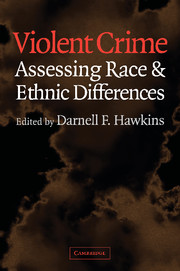Book contents
- Frontmatter
- Contents
- Contributors
- Foreword
- Editor's Introduction
- Violent Crime
- Part I Homicide Studies
- Part II Other Contexts, Settings, and Forms of Violence
- Part III Explaining Racial and Ethnic Differences
- 11 How Can the Relationship between Race and Violence be Explained?
- 12 “Race Effects” and Conceptual Ambiguity in Violence Research: Bringing Inequality Back In
- 13 The Violent Black Male: Conceptions of Race in Criminological Theories
- 14 The Structural-Cultural Perspective: A Theory of Black Male Violence
- 15 A Cultural Psychology Framework for the Study of African-American Morality and Violence
- 16 Racial Discrimination and Violence: A Longitudinal Perspective
- 17 Honor, Class, and White Southern Violence: A Historical Perspective
- References
- Index
16 - Racial Discrimination and Violence: A Longitudinal Perspective
Published online by Cambridge University Press: 22 August 2009
- Frontmatter
- Contents
- Contributors
- Foreword
- Editor's Introduction
- Violent Crime
- Part I Homicide Studies
- Part II Other Contexts, Settings, and Forms of Violence
- Part III Explaining Racial and Ethnic Differences
- 11 How Can the Relationship between Race and Violence be Explained?
- 12 “Race Effects” and Conceptual Ambiguity in Violence Research: Bringing Inequality Back In
- 13 The Violent Black Male: Conceptions of Race in Criminological Theories
- 14 The Structural-Cultural Perspective: A Theory of Black Male Violence
- 15 A Cultural Psychology Framework for the Study of African-American Morality and Violence
- 16 Racial Discrimination and Violence: A Longitudinal Perspective
- 17 Honor, Class, and White Southern Violence: A Historical Perspective
- References
- Index
Summary
A century ago, W. E. B. Du Bois wrote: “Crime is a phenomenon of organized social life, and is the open rebellion of an individual against his social environment” (1899/1996: 235). Explaining crime among blacks in Philadelphia between 1835 and 1895, Du Bois noted their overrepresentation in the courts as well as prisons and was acknowledging the damage to society done by racial discrimination both before and after the Civil War. Enumerations of prison populations in 1904, 1910, and 1923 showed serious overrepresentation of blacks both among resident prisoners and among those committed during the years of enumeration (Reuter, 1927). The fact that rates were higher for population counts than for intakes showed that blacks not only were convicted relatively more frequently but that, also, they were given longer sentences.
High crime rates among blacks are, of course, at least partly a function of the operation of the justice system and the way in which crimes and race are recorded. In many cases, white men have committed violence against blacks with impunity, thus not entering into any counts of violence. Although black recorded rates of violence exceeded the averages among whites, they did not rise to the levels of violence among Irish or Italian immigrants at particular times and places (Lane, 1997). Nevertheless, contemporary records indicate that violence among blacks, particularly among young black males, is an extremely serious phenomenon.
- Type
- Chapter
- Information
- Violent CrimeAssessing Race and Ethnic Differences, pp. 319 - 330Publisher: Cambridge University PressPrint publication year: 2003
- 11
- Cited by



